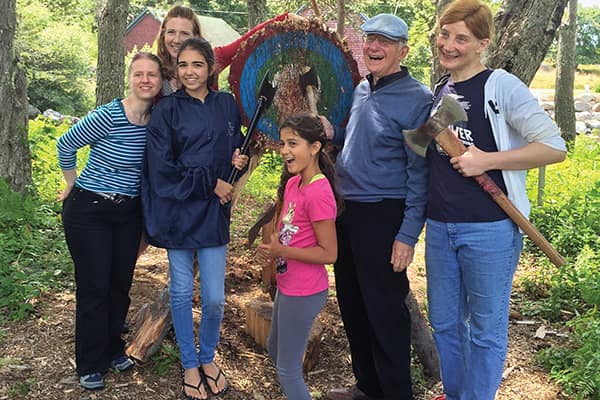New Brunswick’s rugged Fundy coast is in a constant state of flux.
The view from Cape Enrage, NB, seems timeless. There are no buildings, roads or other signs of human life on the beach or on the distant shore of the Bay of Fundy. It’s as though the landscape hasn’t changed for thousands of years, even though, considered from another perspective, everything is in constant flux. Rocks emerge from the swell in a flash and then disappear. Colours flow in ribbons and whirlpools of turquoise, deep blue and ochre.
Cape Enrage, site of the “Best View in Canada” as selected by Frommer’s Travel Guide, juts out from New Brunswick’s rugged Fundy shore. It’s a sparsely populated shoreline of cliffs, beaches, salt marshes and woods.

All along the Fundy coast, the extreme tides carve out sea caves and sculpt rocks. Consider the spectacular Hopewell Rocks. These “flowerpot” rocks—so called because they resemble giant potted plants—formed millions of years ago, and remain works in progress. Several years ago, for example, the “trunk” of what was known as Elephant Rock collapsed due to erosion.
The tides also influence the movements of people. Karen Hine, interpretation coordinator at Fundy National Park, notes how, at low tide, fishing boats of many different colours rest in wooden cradles on the muddy ocean floor. “Once the tide is high enough, the fishermen rush to the wharf to unload the catch.” The difference between high and low tide at Alma can be as much as 12 metres, the equivalent of a four-storey building.
At Alma, the Upper Salmon River empties into the Bay Of Fundy. At low tide, Hine says, if you stand at the river’s mouth, you see water flowing out. “A few hours later, birds and driftwood float upstream, and eddies form where currents meet. At high tide, the estuary looks like a giant lake with the grassy river banks covered by water,” she says.
“You can see different, sometimes surprising, things.” She recalls watching leaping salmon, porpoises and loons, all diving together just by the shore. “Be open,” she says, “to discovering something amazing and fun when the tide goes out.”
In St. Martins, NB, artist Storme Arden creates works from treasures found at low tide. She also photographs symbolic arrangements of beach stones. She feels “people are restored and made more whole through contact with nature and the ocean.” In her work, she expresses “gratitude and reverence to nature.”
From May to October, she and Dorain Henderson sell their paintings, photography and pottery from what, through the winter, is a shack on the wharf filled with fish for lobster bait. In spring, the shack is hosed out, and filled with their art.
The rugged coast often draws people back home from away. After high school, chef Jeremy Wilbur travelled the world working as a cook for several years, then returned to become the chef at The Cape House restaurant at Cape Enrage. “I missed the ocean, my family, and the slower life here. After seeing the world,” he says, “you realize how lucky you are to live here.”
At his restaurant, Wilbur melds lessons learned from his grandmother—like preserving berries in season and baking bread—with a passion for experimentation and newfound flavours; the Cape House menu features unique dishes such as scallop wontons and lobster tacos; Wilbur notes that every year he develops new dishes using traditional ingredients.
Sharon Murphy, Cape Enrage interpreter, says people often come to Cape Enrage at significant times in their lives—for marriage proposals, wedding anniversaries and after funerals. Others come to picnic, and to “recharge their batteries.” Some come for the adventure of rappelling or ziplining.
“At Hopewell Rocks and at the St. Martins’ sea caves,” Murphy observes, “people see what the Bay has done. At Cape Enrage, people feel the power of the Bay. It’s all about extremes here—extreme tides, extreme weather and also extremely good food and artistic talent.” She points out that the craft shop features the work of many talented local artisans.
Down the road, for example, Tim Isaac divides his time between pottery and music. Originally from Manitoba, Isaac describes falling in love with the coastline. “It’s magical,” he says. “Mind-blowing. The moss, the fog, the ruggedness of the rocks.” He feels the area has “an exhilarating and edgy” energy, possibly generated by the constantly changing tides and winds.
Fellow musician Jim Blewett performs with him as part of the musical duo, “Isaac and Blewett,” at weekly summer concerts at Fundy National Park. The group also plays at historic Harvey Hall, a beautiful wooden building that’s on the road to Mary’s Point.
“Freedom is the essence of this place,” says Blewett. “You can walk in any direction for five miles and not meet anyone. That’s so rare. You’ve got both the forest and the shore. And you even have the bottom of the sea.” At low tide, Blewett says, he can walk more than a kilometre out from the high tide mark and find himself metres below sea level.
“The place is primeval,” he says. “You stand at the edge of the bay and it feels like the beginning of time.”



